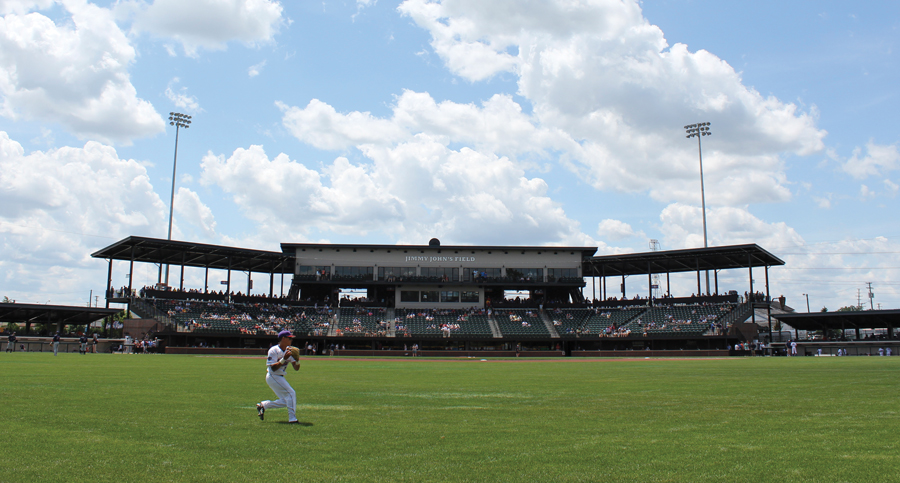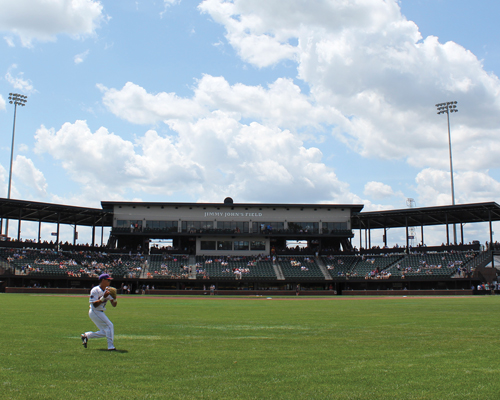
Adjacent to downtown Utica along M-59 just before the freeway morphs into Hall Road is a $16 million gamble, one physically constructed in just 11 months but planned for well over a decade.
It might seem to be an unlikely location for a baseball stadium, especially since it was once a landfill. But given that around 1 million people live within a 12-mile radius of Jimmy Johnãs Field, perhaps the bigger gamble would have been not building it.
So far, itãs working. In 2016, the stadium drew an average of 3,100 fans per game and recorded sellouts in 42 of its 75 games.
Now about to start its second year, the independent, non-affiliated, United Shore Professional Baseball League (USPBL) is looking for ways to expand, and in essence, rewriting the minor league baseball model for success. Especially since they donãt have the backing of a major league team.
In 2016, three teams ã the Utica Unicorns, Eastside Diamond Hoppers, and Birmingham Bloomfield Beavers ã played 75 games combined at the same Utica ballpark. The West Side Wooly Mammoths are being added in 2017, a name inspired by a mammoth unearthed on a Chelsea-area farm a few years ago.
But that is just the start of the expected changes.
ãWe like to say it has been a 10-year, overnight success,ã says Andrew Appleby, the commissioner and brains behind the league. ãEven with all the planning and the best practices we included, the first year exceeded our expectations.ã
Even the most seasoned poker player might feel Appleby went ãall inã on a bit of a gamble. But Appleby wasnãt a stranger to minor league baseball. His parent company, Rochester-based General Sports and Entertainment, previously owned the Ft. Wayne TinCaps ã a Single A affiliated club of Major League Baseballãs San Diego Padres. It functioned under a more traditional minor league model: one team, one park, and a major league affiliation.
But Applebyãs executives learned a few things from that experience. One of the most prominent was that attendance is higher on weekends. This year the number of games will remain the same, but the season will start earlier in the spring and games will only be held on Thursdays through Sundays.
ãEven with all the planning and the best practices we included, the first year exceeded our expectations.ã ã Commissioner Andrew Appleby
And although all four teams will play both ãhomeã and ãawayã games at Jimmy Johnãs Field, future expansion could include 10 to 20 teams. And that would mean the construction of additional stadiums, says USPBL COO Dana Schmitt.
She says the league has been working to find stadium sites throughout Michigan, and if needed, in other parts of the Midwest.
Perhaps the biggest challenge for any independent minor league is to establish legitimacy, not only in the minds of its patrons and sponsors, but in the sport itself. The teams are made up of top-level college baseball players. Itãs a developmental league,ä»sort of ãfinishing schoolã for non-drafted players trying to make it to the big leagues.
So far, so good. Nine players were signed by major league teams from the USPBL squads last year.
ãThere are many advantages to being an independent because you have more freedom to make decisions on operations,ã Schmitt says. ãOne of the biggest downsides though is that you donãt have a major league team funding any of your operations.
Plans for the Utica field go beyond baseball. There has been talk of adding a skating rink at the stadium. Developing an annual concert schedule has also been discussed.
To help make money, the USPBL invested in unique amenities at Jimmy Johnãs Field such as foul line cabanas, a kids whiffle ball park, and sizable picnic area down the leftfield line. Parking is free and shuttle cars take fans to and from Utica lots. Thereãs also a full-service bar behind home plate.
Schmitt says the league has strived to make the stadium a ãDisney-like experienceã with unique mascots and colorful team apparel. Season ticket holders already have the opportunity to take batting practice on the field at some point during the year.
The games are relatively affordable. Tickets range from $6 on the lawn to $40 in the Front Row Club, with grandstand tickets from $12-$25.
Appleby says many of those fans quickly latched on to their ãfavoriteã team last year. ãIn the first playoff game it went down to the final at-bat and there was real electricity in the air,ã he says. ãThe outcome of the game mattered and that is something that really evolved over the summer.ã
So perhaps the dice roll, as it were, wasnãt a gamble after all.
|
| ä» |
|









